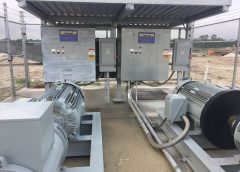A Georgia Sand Producer Finds a Solution to Inconsistent Power Flow.
By Mark S. Kuhar
|
|
  
|
Zach Rountree’s life would be a lot easier if his job site was closer to town. As the owner and president of Rountree Construction, he oversees an operation that pulls 200 tph of an out of a remote lake in Stockton, Ga. Big equipment demands three-phase power, but out in the remote timberlands of rural Georgia, only single-phase power was available.
Rountree Construction runs a surface sand mine, processing sand for the ready-mix industry, masonry products and also sand for golf courses – everything from the sand for bricks to the sand that swallows your golf ball.
Until recently, their sand mine ran rotary phase converters to generate three-phase power. But the phase converters couldn’t take the extreme weather conditions, particularly in the height of a Georgia summer. The high heat and humidity prompt locals to run their air conditioning, which maxes out the electrical grid.
Inconsistent power flow to the rotary phase converters, like the sags that occur when there is a large demand on the grid, would cause them to shut down. Swells in the power supply, like those caused by lightning strikes in the area, a common summertime occurrence, would also cause the rotary phase converters to kick out. So Rountree approached his local utility company, which suggested installing a Single Phase 1-to-3 Microgrid Power Source.
Keeping Current
Demand for three-phase power is growing much faster than the availability of three-phase service, particularly in rural and agricultural areas of the nation. In the late 1980s, when Rountree established the sand mine, three-phase service was even harder to find.
Rountree’s open dredge system ran a rotary phrase converter to convert the single-phase service to three-phase power. A dredge pumps material from the lakebed to a processing plant, where sand is washed, drained, dried and prepared for delivery.
The sand mine operates three production lines six days a week, 360 days a year. All said, upwards of 10 different motors run 10 to 12 hours a day, creating a huge demand for consistent power.
As stated previously, during the dog days of a Georgia summer, temperatures and humidity soar. Locals crank up the air conditioning, which maxes out the local power grid. On top of that, lightning strikes two to three times a week, causing power surges and outages, tripping the rotary phrase converters and kicking them off.
“We’d have to run out there and restart it quickly, or the whole system would get gunked up: all the pipes would clog with material, it was a big mess,” Rountree remembered.
It was a common problem. And with production shut down from 15 minutes to 6 hours, it was more than just a nuisance, it was expensive. If crews were unable to re-start the converters before a jam was created, they’d have to manually clear the jam, which meant unbolting pipes, unplugging the pipes, rinsing the system, and restarting the production line. From Rountree’s perspective, that meant he was paying to clear the jams and paying for the production – so his labor costs were basically doubled for the time spent cleaning.
A Powerful Solution
Rountree, tired of the labor costs to restart the motors and clean up clogged production lines, approached the local utility company, which provided the rotary phase converters, to see if there were any other alternatives.
They recommended Single Phase Power Solutions, producers of high horespower single-phase motors, specifically their 1-to-3 Microgrid Power Source utilizing the patented BELLE Written-Pole motor. Generating clean, stable, three-phase power with the pair of 100-hp 1-to-3s has simplified the power process and resulted in more reliable and consistent power, even in the heat of summer. Every morning, Rountree starts a motor by the water pump. From there, he can hear the strain on the 1-to-3 Microgrid Power Source, and when it settles (after a few seconds), he hits the start button. Power flows throughout the plant, pulling the first tons of material up for the day.
“It’s a lot more simple than I thought it was going to be,” Rountree admits.
The 1-to-3 allows weak single-phase lines to deliver three-phase power with excellent voltage regulation and precise 60-Hz frequency. The generator output provides well-balanced power capable of starting and running Rountree’s largest production lines, despite running ten motors with no breaks. Fresh water lines feed the flow to the plant, flowing through a 10-in. line to a clarifying tank which drains and provides a preliminary scrub of the material. From here the flow goes to the log washers, fine aggregate screws and then to a conveyor belt.
While the process is not terribly complex, all aspects of production are powered by three-phase motors. When power outages cause material jams, it requires a bit of elbow grease to clear them.
The Single Phase Power Solutions equipment has been in place for over eight-plus months, including the hottest days of the summer, without fail. No motors kicking off, no running out to get everything back online before the material clogs pipes, and most importantly, no production downtime.
Each of the 1-to-3 Microgrid Power Source solutions generates 100 hp of total power, which can power several motors. One of those motors can be equal to half of the 1-to-3’s output, or 50 hp, with the remaining power distributed among smaller motors totaling the other half of the capacity. The largest motor that Rountree powers is a 30-hp fresh water pump, which feeds the wash plant.
“Any sort of disruption would kick out the old rotary phase converters,” recalled Rountree, “but the Single Phase product has run very constant, with no problems.”
Since the local utility owns the equipment and sells the three-phase power to Rountree, he has not noticed a decrease in his rates. But he is pleasantly surprised with uptime that his plant achieves due to the stable power supply generated by the 1-to-3s.

